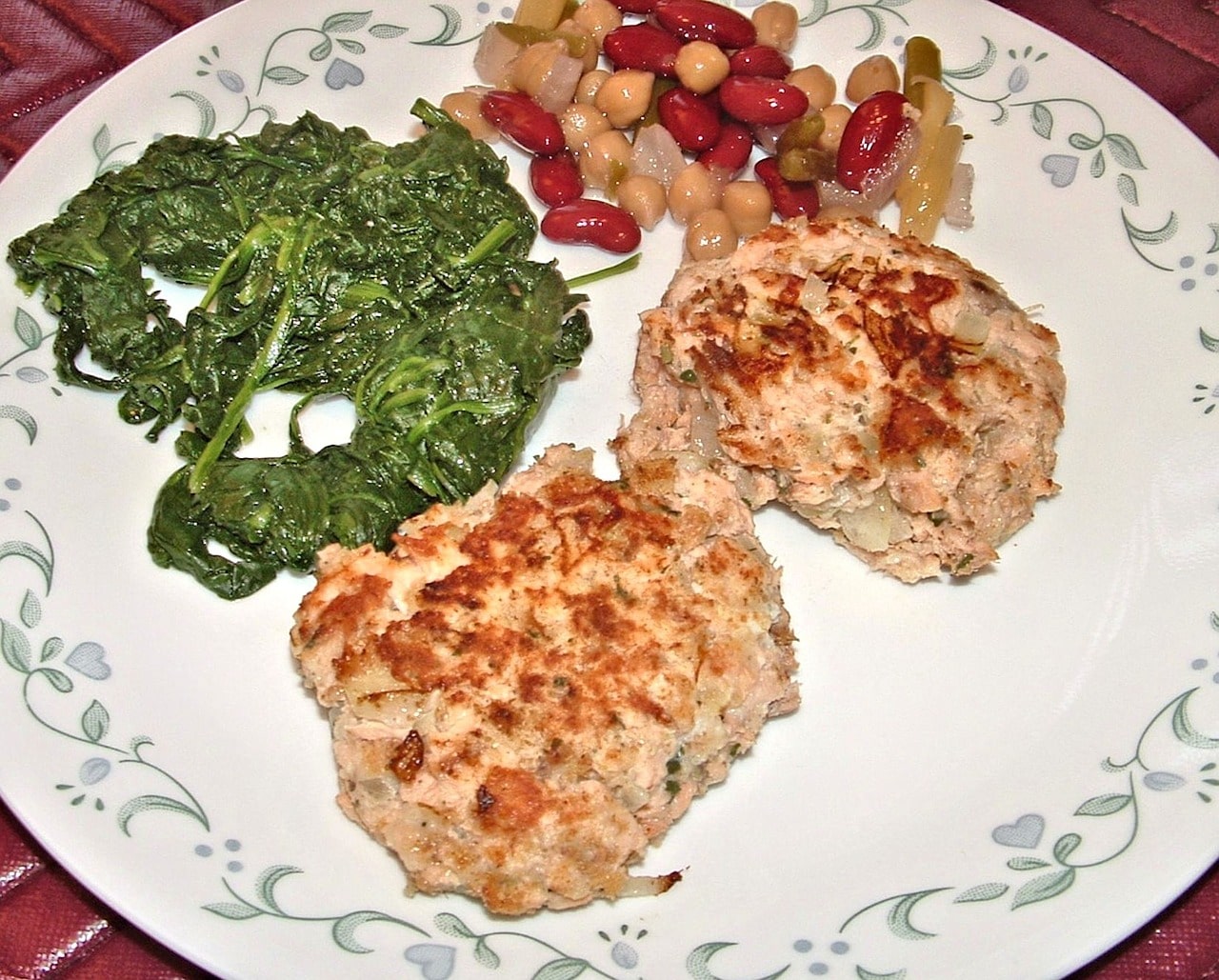Consuming heart-healthy salmon patties is a dream to many because there are just so many foods and beverages that can weaken and clog the heart (and cause other health disorders).
Salmon (both the farm-raised and wild kinds) is considered a healthy protein source, and it makes sense for people to eat more old fashioned salmon patties recipes if they want to stay healthier, longer. Gluten-free salmon patties use binders that don’t have gluten, which is not safe for people with IBS and Celiac disease.
Baked salmon patties (and the grilled ones) require less oil in the binder, so you can further cut down your patties’ fat content if you are preparing them at home.
Fresh salmon patties can be made daily, and you can certainly serve more fish to your kids this way if they generally turn their noses up at salmon and other kinds of fish in other recipes.
Are Salmon Patties Bad for You?
Salmon patties are one of the healthiest fast food items around. So if you want to eat out with friends and do not like to ruin your diet (that much), we recommend selecting fishcakes and salmon burgers. You can even eat two salmon burgers and get the same amount of calories as a double cheeseburger from McDonald’s.
One serving of McDonald’s double cheeseburger is around 420 calories, with ten grams of saturated fat and 0.5 gram of trans fat. Cheeseburgers also have a ton of sodium (around 1030 mg) and 70 milligrams of cholesterol.
Let’s take a look at what salmon burgers can offer. Salmon burgers are a natural source of omega-3 fatty acids, which occur naturally in salmon. You can get up to two grams of these beneficial fatty acids for every four ounces of salmon.
This is already 50% of the RDA for omega-3 fatty acids. Eat eight ounces of salmon patty per day, and you gain 100% of your needs – there’s no more need for omega-3 supplementation for the day. Salmon also contains DHA, which has a direct impact on the brain.
Docosahexaenoic acid or DHA is protective of both the cardiovascular system and the brain. DHA is also marketed as a natural memory-booster. There is nothing wrong with trying more DHA in your diet, as it will benefit your health one way or another.
Are Salmon Cakes Gluten-Free?
Not all salmon cakes are gluten-free, but some commercially-made ones are made specifically for people who have gluten-free food requirements. The regular salmon cakes served in restaurants and fast food joints are not gluten-free unless the establishment specifies.
Salmon Cake Nutrition Facts
If you are making some homemade salmon cakes, it’s best to know how many calories you are consuming per serving if you are interested in kick-starting your weight loss efforts. If you make salmon cakes from canned salmon, which is the most common choice for many home cooks because canned salmon is very convenient, then one serving of salmon patty will give you 250 calories.
A patty would also provide 11.4 grams of fat, comprised of three grams of saturated fats, 3.4 grams of polyunsaturated fat, and 3.7 grams of monounsaturated fat. The two previous fat types are good for the heart, making salmon patties an equal choice if you want heart-healthy food.
Homemade salmon patties will have variable quantities of cholesterol depending on the number of eggs you add as a binder if you add one large whole egg to the mix, which provides roughly 154 grams of cholesterol.
There will also be variability in the sodium content. If you add more salt to your patties, the sodium content will go up. The average sodium content of homemade patties is about 175 mg of salt per serving. You can get plenty of potassium naturally from the fish at 519 mg for every patty.
Unlike other foodstuffs served in fast food joints and restaurants, salmon cake or salmon patties have plenty of nutrients to provide. It has magnesium, vitamin A, iron, folate, vitamin B12, copper, vitamin B6, vitamin D, vitamin C, calcium, and vitamin E. Salmon is also packed with high zinc, thiamin, selenium, riboflavin, phosphorous, and pantothenic acid.
What Can You Pair with Salmon Cakes to Make Them Healthier?
If you don’t like to eat salmon cakes or salmon patties with bread, you don’t have to. You can eat salmon cakes on their own, or better yet, pair your salmon cakes with some great sides and dishes that are healthy, too. One of our favorite dishes for pairing with salmon cakes is lemon pasta.
You can make lemon pasta in just fifteen minutes, and the taste is divine and refreshing in the mouth, too. If you have trouble eating fish because of the natural flavor profile, eating something with citrus will take care of any aftertastes you don’t like. The next dish that you might want to try is green beans with some butter. They’re a regular go-to for baked and fried fish dishes. Finish the buttery goodness off with some fresh lemon zest, and you are good to go.
For those who want more starch with their meals, go straight to rosemary potatoes. Roast the potatoes first or bake them while seasoning the wedges or chopped potatoes with salt, pepper, and rosemary. We’re after a slightly crispy exterior with a softer core. We want that extra crunch to match the crunchiness of the salmon patties, too.
Make sure you top the rosemary potatoes with generous helpings of parmesan cheese and garlic. Garlic powder is fine, but pan-roasted garlic will bring even more flavor. It depends on you on what you want to achieve with the dish. For better flavors, always roast your garlic and onions in any recipe. Be sure to make some more because your friends or family will be coming to you for seconds, for sure.

